

Shared heritability of attention-deï¬ cit/hyperactivity disorder and autism spectrum disorder. Attention-Deficit Disorders and Epilepsy in Childhood: Incidence, Causative Relations and Treatment Possibilities. Rami Kaufmann, MD Hadassa Goldberg-Stern, MD Avinoam Shuper, MD At least 20% of children with epilepsy have clinical attention-deficit hyperactivity disorder (ADHD) compared to 3% to 7% of the general pediatric population.
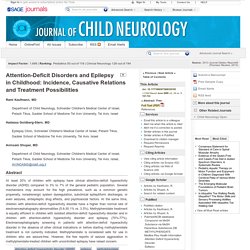
Several mechanisms may account for the high prevalence, such as a common genetic propensity, noradrenergic system dysregulation, subclinical epileptiform discharges, or even seizures, antiepileptic drug effects, and psychosocial factors. At the same time, children with attention-deficit hyperactivity disorder have a higher than normal rate of electroencephalography abnormalities (5.6-30.1% vs. 3.5%). Attention Deficit Hyperactive Disorder. The ADD, ADHD, learning disabilities, and education fields are so full of acronyms and specialized words that it can be very hard for a non-professional in the field to understand what is being communicated.
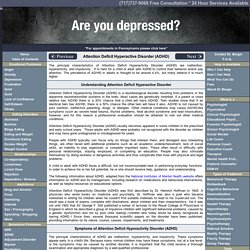
Included here are many of the abbreviations and words that are frequently used. This glossary has been adapted from the LD Online website. academic English The English language ability required for academic achievement in context-reduced situations, such as classroom lectures and textbook reading assignments. This is sometimes referred to as Cognitive/Academic Language Proficiency (CALP). accommodation Techniques and materials that allow individuals with LD to complete school or work tasks with greater ease and effectiveness. Accuracy The ability to recognize words correctly. adequate yearly progress (AYP) An individual state's measure of yearly progress toward achieving state academic standards. Morning and evening behavior in children and adolescents treated with atomoxetine once daily for Attention-Deficit/Hyperactivity Disorder (ADHD): Findings from two 24-week, open-label studies.
Potential hormonal mechanisms of Attention-Deficit/Hyperactivity Disorder and Major Depressive Disorder: A new perspective. Review a Psychology Department, University of New Orleans, USAb Psychology Department, Michigan State University, USA Received 12 September 2008, Revised 9 January 2009, Accepted 10 February 2009, Available online 2 March 2009 Choose an option to locate/access this article: Check if you have access through your login credentials or your institution Check access doi:10.1016/j.yhbeh.2009.02.004.
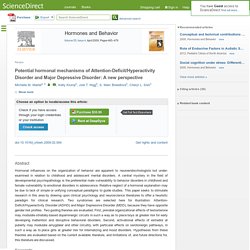
Psychiatric Comorbidities in Children with Attention Deficit Hyperactivity Disorder: Implications for Management. ADHD in college students: Developmental findings. Inhibitory functioning across ADHD subtypes: Recent findings, clinical implications, and future directions. Primitive Reflexes and Attention-Deficit/Hyperactivity Disorder: Developmental Origins of Classroom Dysfunction. The present research studied the symptomatologic overlap of AD/HD behaviours and retention of four primitive reflexes (Moro, Tonic Labyrinthine Reflex [TLR], Asymmetrical Tonic Neck Reflex [ATNR], Symmetrical Tonic Neck Reflex [STNR]) in 109 boys aged 7-10 years.

ADHD candidate gene (DRD4 exon III) affects inhibitory control in a healthy sample. ADHD candidate gene (DRD4 exon III) affects inhibitory control in a healthy sample. Practitioner Review: Non-pharmacological treatments for ADHD: A lifespan approach. A Combined Treatment Approach for Adults With ADHD. Atomoxetine for the treatment of attention-deficit/hyperactivity disorder (ADHD) in children with ADHD and dyslexia. Study Design This open-label, non-randomized, parallel-design pilot study was conducted from October 2003 to March 2006 at 12 centers in the United States.

The study protocol was approved and conducted in accordance with the principles of the Declaration of Helsinki, and all parents or legal guardian(s) of the patients provided written informed consent (and patients provided assent where applicable) after the procedure(s) and possible side effects were fully explained. All patients meeting criteria received open-label treatment with atomoxetine at doses ranging from 1.0-1.4 mg/kg once daily given orally as capsules (Strattera®, Eli Lilly and Company, Indianapolis, IN, USA) for approximately 16 weeks. The maximum dose prescribed was 1.4 mg/kg or 100 mg, whichever dose was less. After initiating treatment, patients were assessed every 2 weeks for 8 weeks and then once a month for the remaining 8 weeks of the study. Patients Efficacy Measures Safety Statistical Methods.
Atomoxetine treatment and ADHD-related difficulties as perceived by adolescent patients, their parents and physicians. Patient population and disposition Of the 160 patients screened, 159 patients (100%) were enrolled in the study and treated with atomoxetine, 137 (86.2%) patients completed the treatment period and continued into the extension period. 20 (12.6%) patients discontinued early over the course of the 8 week treatment period, two more (1.3%) completed the treatment period, but did not continue into the extension period based on the decision of the physician. 26 (16.4%) patients discontinued between weeks 8 and 24. 111 (69.8%) patients completed the study at week 24.
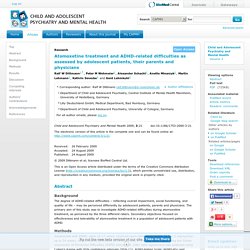
Discontinuations were mostly due to lack of efficacy. All reasons for discontinuation are shown in Figure 1. Table 1 shows the patient characteristics. Male patients and those with the combined subtype of ADHD appeared to be younger and to be diagnosed earlier than girls or patients with the predominantly inattentive subtype. 68 (54.4%) boys and 13 (38.2%) girls were diagnosed with the combined subtype.
Table 2. Figure 2. Table 3. Molecular genetics of attention-deficit/hyperactivity disorder: an overview. Explosive, oppositional, and aggressive behavior in children with autism compared to other clinical disorders and typical children. Department of Psychiatry, Penn State College of Medicine, Hershey, PA, United States Received 16 August 2011, Accepted 17 August 2011, Available online 21 September 2011 Choose an option to locate/access this article: Check if you have access through your login credentials or your institution Check access doi:10.1016/j.rasd.2011.08.001.

The history of attention deficit hyperactivity disorder. Impact of attention-deficit/hyperactivity disorder on the patient and family: Results from a European survey. Sample characteristics Responses to the surveys were received from 1905 parents (ADHD parent sample, n = 910; normative population parent sample, n = 995) (Figure 1).

The demographic and baseline characteristics of the responding parents and their children are provided in Table 2. The questionnaires were predominantly completed by mothers. As in most studies of ADHD, there was a strong male preponderance, with the majority of children described in the survey being boys (76% in both survey groups). Attention Deficit/Hyperactivity Disorder: A Focused Overview for Children’s Environmental Health Researchers. The relationship between attention, executive functions and reading domain abilities in attention deficit hyperactivity disorder and reading disorder: a comparative study - Bental - 2007 - Journal of Child Psychology and Psychiatry. The Shifting Subtypes of ADHD: Classification Depends on How Symptom Reports are Combined.
Neuro Developmental Therapy. Attention Deficit Disorder (ADD) and Attention Deficit Hyperactivity Disorder (ADHD) - describe the condition under which an individual may have poor concentration, short term memory loss, hyperactivity, inability to sit still or to be quiet or to follow sequential instructions.
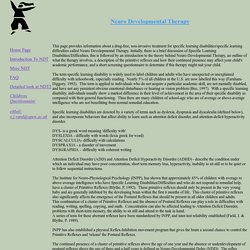
The Institute for Neuro-Physiological Psychology (INPP), has shown that approximately 85% of children with average to above average intelligence who have Specific Learning Disabilities/Difficulties and who do not respond to remedial help, have a cluster of Primitive Reflexes (Blythe, P, 1992). These primitive reflexes should only be present in the very young baby and are generally inhibited by the developing brain within the first 6 months of life. This cluster of primitive reflexes also significantly affects the emergence of the Postural Reflexes that should be present in all older children and adults. Peer problems in Attention Deficit Hyperactivity Disorder: Current status and future directions. A 13-hour laboratory school study of lisdexamfetamine dimesylate in school-aged children with attention-deficit/hyperactivity disorder.
This randomized, double-blind, multicenter, placebo-controlled, dose-optimization, crossover, laboratory school study of LDX was conducted at 7 study sites in the United States.

Subjects were recruited from June through December 2007. All study activities were performed in accordance with the principles of the International Conference on Harmonization Good Clinical Practice, 18th World Medical Assembly (Helsinki 1964), and amendments of the 29th (Tokyo 1975), the 35th (Venice 1983), the 41st (Hong Kong 1989), and the 48th (South Africa 1996) World Medical Assemblies. A Process for Developing Community Consensus Regarding the Diagnosis and Management of Attention-Deficit/Hyperactivity Disorder. + Author Affiliations Abstract There remain large discrepancies between pediatricians' practice patterns and the American Academy of Pediatrics (AAP) guidelines for the assessment and treatment of children with attention-deficit/hyperactivity disorder (ADHD).
Several studies raise additional concerns about access to ADHD treatment for girls, blacks, and poorer individuals. Barriers may occur at multiple levels, including identification and referral by school personnel, parents' help-seeking behavior, diagnosis by the medical provider, treatment decisions, and acceptance of treatment. Such findings confirm the importance of establishing appropriate mechanisms to ensure that children of both genders and all socioeconomic, racial, and ethnic groups receive appropriate assessment and treatment. ADHD Medications and Risk of Serious Cardiovascular Events in Young and Middle-aged Adults.
Speed of Language Comprehension is Impaired in ADHD. Parental beliefs about the nature of ADHD behaviours and their relationship to referral intentions in preschool children. Overlap of ADHD and Oppositional Defiant Disorder DSM-IV Derived Criteria. Impulsiveness as a timing disturbance: neurocognitive abnormalities in attention-deficit hyperactivity disorder during temporal processes and normalization with methylphenidate. The site for and by adults with ADHD. The neurobiological profile of girls with ADHD. Facts, values, and Attention-Deficit Hyperactivity Disorder (ADHD): an update on the controversies. Cost of Illness and Comorbidities in Adults Diagnosed With Attention-Deficit/Hyperactivity Disorder: A Retrospective Analysis. CHADD - Nationally recognized authority on ADHD. ADHD - In-Depth Report - NY Times Health.